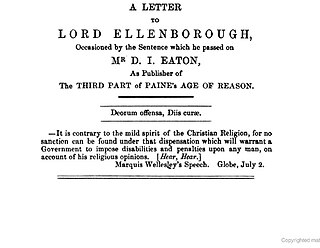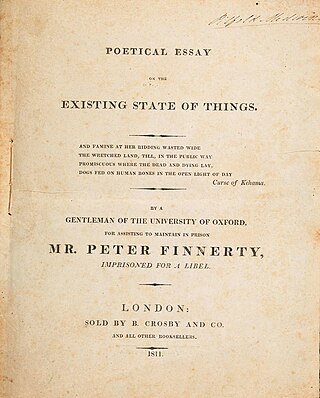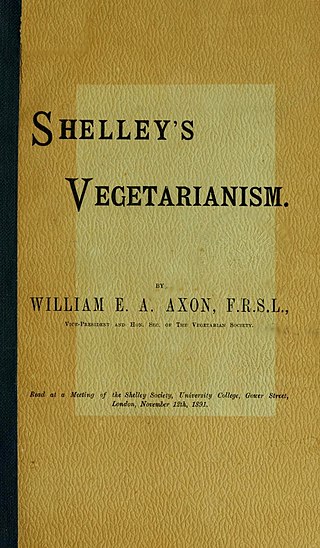This article contains information about the literary events and publications of 1811.

Edward Dowden was an Irish critic, professor, and poet.
Queen Mab is a fairy referred to in William Shakespeare's play Romeo and Juliet, where "she is the fairies' midwife". Later, she appears in other poetry and literature, and in various guises in drama and cinema. In the play, her activity is described in a famous speech by Mercutio published originally in prose and often adapted into iambic pentameter, in which she is a miniature creature who performs midnight pranks upon sleepers. Being driven by a team of atomies, she rides her chariot over their noses and "delivers the fancies of sleeping men". She is also described as a midwife to help sleepers "give birth" to their dreams. Later depictions have typically portrayed her as the Queen of the Fairies.

Thomas Jefferson Hogg was a British barrister and writer best known for his friendship with the Romantic poet Percy Bysshe Shelley. Hogg was raised in County Durham, but spent most of his life in London. He and Shelley became friends while studying at University College, Oxford, and remained close until Shelley's death. During their time at Oxford they collaborated on several literary projects, culminating in their joint expulsion following the publication of an essay titled "The Necessity of Atheism". They remained good friends, but their relationship was sometimes strained because of Hogg's attraction to the women who were romantically involved with Shelley.

George Rowley was Dean and Master of University College, Oxford and Vice-Chancellor of Oxford University.

The Shelley Memorial is a memorial to the English poet Percy Bysshe Shelley (1792–1822) at University College, Oxford, England, the college that he briefly attended and from which he was expelled for writing the 1811 pamphlet "The Necessity of Atheism".

Queen Mab; A Philosophical Poem; With Notes, published in 1813 in nine cantos with seventeen notes, is the first large poetic work written by Percy Bysshe Shelley (1792–1822), the English Romantic poet.
Nationality words link to articles with information on the nation's poetry or literature.

Zastrozzi: A Romance is a Gothic novel by Percy Bysshe Shelley first published in 1810 in London by George Wilkie and John Robinson anonymously, with only the initials of the author's name, as "by P.B.S.". The first of Shelley's two early Gothic novellas, the other being St. Irvyne, outlines his atheistic worldview through the villain Zastrozzi and touches upon his earliest thoughts on irresponsible self-indulgence and violent revenge. An 1810 reviewer wrote that the main character "Zastrozzi is one of the most savage and improbable demons that ever issued from a diseased brain".

Percy Bysshe Shelley was a British writer who is considered one of the major English Romantic poets. A radical in his poetry as well as in his political and social views, Shelley did not achieve fame during his lifetime, but recognition of his achievements in poetry grew steadily following his death, and he became an important influence on subsequent generations of poets, including Robert Browning, Algernon Charles Swinburne, Thomas Hardy, and W. B. Yeats. American literary critic Harold Bloom describes him as "a superb craftsman, a lyric poet without rival, and surely one of the most advanced sceptical intellects ever to write a poem."

James Griffith (1761–1821) was an Oxford academic and administrator. He was elected as a Fellow of University College, Oxford in 1784. From 22 January 1808, he was Master of the College until his death in 1821.

Michael O'Neill was an English poet and scholar, specialising in the Romantic period and post-war poetry. He published four volumes of original poetry; his academic writing was praised as "beautifully and lucidly written".

St. Irvyne; or, The Rosicrucian: A Romance is a Gothic horror novel written by Percy Bysshe Shelley in 1810 and published by John Joseph Stockdale in December of that year, dated 1811, in London anonymously as "by a Gentleman of the University of Oxford" while the author was an undergraduate. The main character is Wolfstein, a solitary wanderer, who encounters Ginotti, an alchemist of the Rosicrucian or Rose Cross Order who seeks to impart the secret of immortality. The book was reprinted in 1822 by Stockdale and in 1840 in The Romancist and the Novelist's Library: The Best Works of the Best Authors, Vol. III, edited by William Hazlitt. The novella was a follow-up to Shelley's first prose work, Zastrozzi, published earlier in 1810. St. Irvyne was republished in 1986 by Oxford University Press as part of the World's Classics series along with Zastrozzi and in 2002 by Broadview Press.

"A Letter to Lord Ellenborough" is a pamphlet written in 1812 by Percy Bysshe Shelley in defence of Daniel Isaac Eaton. Printed in Barnstaple, the essay is approximately 4,000 words in length.

Mary Wollstonecraft Shelley was an English novelist who is best known for writing the Gothic novel Frankenstein; or, The Modern Prometheus (1818), which is considered an early example of science fiction. She also edited and promoted the works of her husband, the Romantic poet and philosopher Percy Bysshe Shelley. Her father was the political philosopher William Godwin and her mother was the philosopher and women's rights advocate Mary Wollstonecraft.

Posthumous Fragments of Margaret Nicholson was a collection of poetry published in November, 1810 by Percy Bysshe Shelley and his friend Thomas Jefferson Hogg while they were students at Oxford University. The pamphlet was subtitled: "Being Poems found amongst the Papers of that Noted Female who attempted the Life of the King in 1786. Edited by John Fitzvictor." The pamphlet was published by John Munday and Henry Slatter in Oxford and consisted of fictional fragments that were in the nature of a hoax and prank or burlesque.

A Vindication of Natural Diet is an 1813 book by Percy Bysshe Shelley on vegetarianism and animal rights. It was first written as part of the notes to Queen Mab, which was privately printed in 1813. Later in the same year the essay was separately published as a pamphlet.

"Poetical Essay on the Existing State of Things" is an essay by Percy Bysshe Shelley published in 1811. The work was lost since its first appearance until a copy was found in 2006 and made available by the Bodleian Library in 2015. The anti-war and anti-imperialist work was intended to raise money for the radical Irish journalist Peter Finnerty, who had been imprisoned for libeling the Anglo-Irish politician Robert Stewart, Viscount Castlereagh, whom he accused of mistreating United Irish prisoners. The work is a precursor to The Masque of Anarchy and "England in 1819".

Since the initial publication of Mary Wollstonecraft Shelley's novel Frankenstein; or, The Modern Prometheus in 1818, there has existed uncertainty about the extent to which Mary Shelley's husband, Percy Bysshe Shelley, contributed to the text. While the novel was conceived and mainly written by Mary, Percy is known to have provided input in editing and publishing the manuscript. Some critics have alleged that Percy had a greater role—even the majority role—in the creation of the novel, though mainstream scholars have generally dismissed these claims as exaggerated or unsubstantiated. Based on a transcription of the original manuscript, it is currently believed that Percy contributed between 4,000 and 5,000 words to the 72,000 word novel.

Shelley's Vegetarianism is a 1891 pamphlet on the vegetarianism of Percy Bysshe Shelley by William Axon, published by the Vegetarian Society. It is a printing of a lecture delivered by Axon before the Shelley Society, at University College in 1890.




















